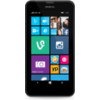Nokia Lumia 635 User Guide - Page 111
Protect your device from harmful content, Information on health, Vehicles - reviews
 |
View all Nokia Lumia 635 manuals
Add to My Manuals
Save this manual to your list of manuals |
Page 111 highlights
Some wireless devices may interfere with some hearing aids. Your device complies with FCC rules on hearing aid compatibility. These rules require an M3 rating or higher. The M value of your device is marked on the device sales package. To determine the M-rating of your hearing aid and compatibility with this device, consult your hearing health professional. For more info about accessibility, go to www.nokiaaccessibility.com. To use a telecoil-equipped hearing aid with this device, activate the hearing aid (T switch) and the device telecoil. The sound quality depends on the type of your hearing aid. Protect your device from harmful content Your device may be exposed to viruses and other harmful content. Take the following precautions: • Be cautious when opening messages. They may contain malicious software or otherwise be harmful to your device or computer. • Be cautious when accepting connectivity requests, browsing the internet, or downloading content. Do not accept Bluetooth connections from sources you do not trust. • Only install and use services and software from sources that you trust and that offer adequate security and protection. • Install antivirus and other security software on your device and any connected computer. Only use one antivirus app at a time. Using more may affect performance and operation of the device and/or computer. • If you access preinstalled bookmarks and links to third party internet sites, take the appropriate precautions. Microsoft Mobile does not endorse or assume liability for such sites. Information on health The U.S. Food and Drug Administration (FDA) and the U.S. Federal Communications Commission (FCC) published statements and questions and answers concerning mobile telephones and health. Microsoft Mobile encourages you to visit these websites for updated information. You can access the FDA website at www.fda.gov/Radiation-EmittingProducts/ RadiationEmittingProductsandProcedures/HomeBusinessandEntertainment/CellPhones/default.htm and the FCC website at transition.fcc.gov/oet/rfsafety/rf-faqs.html. Additional health-related information is available from the World Health Organization (WHO) at www.who.int/mediacentre/factsheets/fs193/en/ and The National Cancer Institute ("NCI") www.cancer.gov/ncicancerbulletin/NCI_Cancer_Bulletin_092308/page7. In the event that you are concerned about possible health effects, the FDA suggests that you limit your own or your children's radio frequency (RF) exposure by limiting the length of calls or by using handsfree devices. Vehicles Radio signals may affect improperly installed or inadequately shielded electronic systems in vehicles. For more info, check with the manufacturer of your vehicle or its equipment. Only qualified personnel should install the device in a vehicle. Faulty installation may be dangerous and invalidate your warranty. Check regularly that all wireless device equipment in your vehicle is mounted and operating properly. Do not store or carry flammable or explosive materials in the same compartment as the device, its parts, or accessories. Do not place your device or accessories in the air bag deployment area. Safety and texting while driving Safety should be every driver's first priority. Drivers must obey all local laws that may include restrictions on the use of mobile telephones or accessories while driving. If use is legal, always keep your hands free to operate the vehicle while driving and use a handsfree device whenever possible. Suspend calls in heavy traffic or hazardous weather. Get to know your mobile phone and its features and make any necessary information inputs prior to driving. Do not input data or engage in text messaging while driving. Mobile telephones should not be used when use may be a distraction to the driver. The Cellular Telecommunications & Internet Association (CTIA) has published further info and tips on safe use of cellular telephones at www.ctia.org/consumer_info/safety, which we encourage you to review. Potentially explosive environments Switch your device off in potentially explosive environments, such as near gas station pumps. Sparks may cause an explosion or fire resulting in injury or death. Note restrictions in areas with fuel; chemical plants; or where blasting operations are in progress. Areas with a potentially explosive environment may not be clearly marked. These usually are areas where you are advised to © 2014 Microsoft Mobile. All rights reserved. 111












